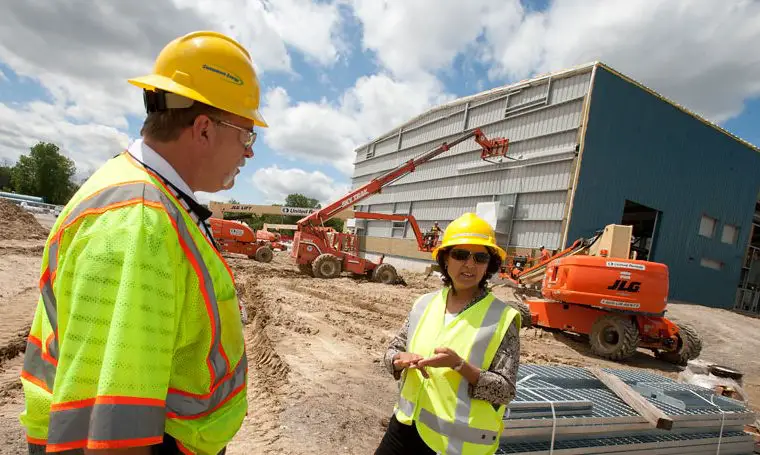It is very unlikely that a casual observer would pay too much attention to a construction site, except perhaps to complain about the inconvenience, dust and noise levels. On the other side of the fence is where everything is happening. A considerable amount of planning and strategising is required to set up even the most basic construction site and when the project is of a higher magnitude, this planning reaches a phenomenal level of complexity. Space is always going to be limited, so the ultimate objective will be to optimise the space that is available for the duration of the project while adhering to statutory health and safety requirements.
Site Facilities
Every site contains a mix of permanent and temporary facilities. The permanent facilities include the infrastructural framework of the local water and sewer reticulation points, as well as the local power supply network. They also include the existing fencing and natural boundaries, any local gas pipelines and the building that is under construction. The site office and all workshops, storage areas, site utilities and plant equipment comprise the temporary facilities that need to be set up within the boundaries of the space allocated for the project. An experienced site planner will likely begin a site layout plan by using a grid design with the permanent facilities clearly marked out. Because of the critical importance of maximising site layout efficiency while minimising cost, a number of software applications that address and simplify these issues have been developed. However, these software applications will not be covered in this article.

Shortest Distance between Two Points
A huge amount of careful planning is required to establish an effective layout for any construction site. All projects have deadlines and budgetary constraints, so it is important to make sure that no time gets wasted on poor site traffic efficiency, both pedestrian traffic and movement of construction materials. The primary focus of an efficient site layout design will need to be on the optimal flow and movement of workers and materials in and around the fixed and temporary facilities on the site. Remember to include the supply of water and power as well as rubble and waste removal in this flow. Once these flows are identified and mapped out, it will be a lot simpler to factor in the movement of heavier plant equipment, particularly with regard to safety on the construction site. Again, a grid design is useful for calculating permanent and temporary facility placement and distances that will need to be travelled by site workers and plant equipment. The best site layout will provide minimal time spent on workers moving between various points with the maximum work hours per day output.
Safety First
Construction site safety is a universal requirement that requires very precise attention. Taking shortcuts to reduce costs or to expedite project completion may be very tempting but it creates the potential for an industrial accident and a pile of unwanted attention from the authorities, as well as loss of investor funding. Every site requires a thorough risk assessment, including paying attention to the smallest details. Something as seemingly simple as two adjacent planks could be the cause of a severe finger injury, so instilling a risk awareness culture among site personnel is essential. Taking into account the delays caused by lost time injuries (LTI) it is vital to implement stringent site safety protocols in accordance with national safety legislation and company policies. Project managers and site agents need to be prepared for unexpected site safety audits by the relevant authorities.
Good Fences, Good Neighbours
A construction project does not happen in isolation. Whether it is in a city or a suburb, the goodwill of the community remains an important consideration. Noise and dust are always going to be points of concern, and while noise levels are very difficult to address, dust and pollution control are issues that need to be addressed in a proactive manner, especially in this era of environmental awareness. Add into the mix the fact that access to a construction site needs to be strictly limited to authorised personnel to avoid the possibility of civilian injuries and potential instances of vandalism. The only way to effectively deal with these problems is to install fencing around the site perimeter. Traditional mesh fencing limits access to a site but does nothing to minimise the unwelcome spread of dust and definitely does not limit visibility of the site layout. The solution to both these issues is to use fence wraps.
Versatile Security
Mesh banners provide an excellent means of limiting pedestrian access to construction sites and for keeping the chaos of construction sites away from the public eye as well as providing a budget friendly, re-usable solution to demarcations zones within construction sites.
Mesh banners have thousands of small perforations that act as a channel for wind, which helps to reduce wind strain on the construction site fence. Mesh banners are also tough, durable and waterproof, making them perfect for use within the construction site enclosure itself, especially when used as barricades or fencing for temporary limited-access areas. Best of all, mesh banners are printable, which makes them a perfect means of communicating information, both on site and to the community at large. On-site communication can be anything from simple signage indicating the directions to the ablution facilities or site office to demarcation of hazardous zones that limit access to everyone except duly authorised personnel. Off-site communication provides the opportunity to share information with the community about the nature and progress of the construction project, as well as the chance to advertise the construction company.
Wrapping it Up
An experienced project manager and site agent will have very little trouble organising a construction site layout to achieve optimal efficiency of movement at the lowest cost. With the added benefit of choosing the correct construction site enclosures and limited access barricades, there is every likelihood that the planned construction project will be successfully completed in time and within budget.

